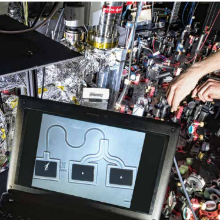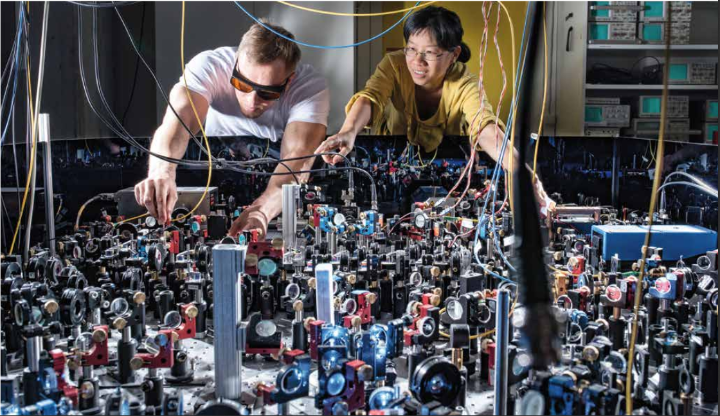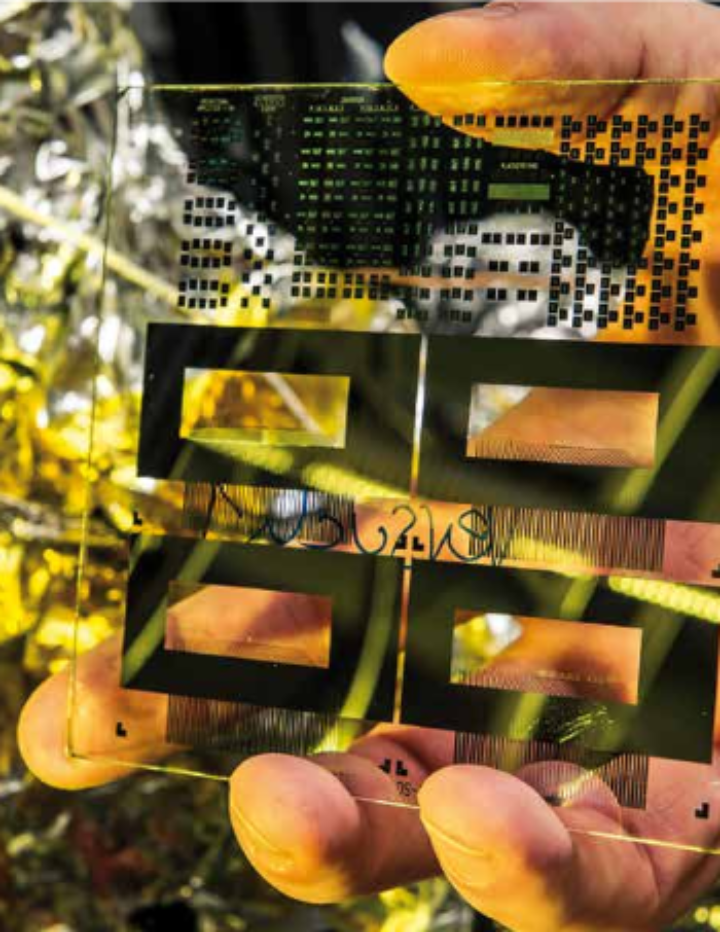With the Center for Integrated Quantum Science and Technology (IQST), the Universities of Stuttgart and Ulm are jointly positioning themselves for a development leap that will affect many areas of technologies. It is expected that sensors, communication technologies and computers will eventually be able to exploit fundamental quantum physical effects to become more sensitive and reliable than their contemporary counterparts. Scientists are now collaborating in an interdisciplinary effort to ease the transition path from pure science to technical application.
We have now become so accustomed to certain everyday technological innovations that nobody really thinks any more about how some of these things even work the way they do. DVDs, smart phones, the Internet, flat-screen TVs, LEDs – yet all of these things that we now take for granted are the results of research carried out decades ago at a whole range of scientific research institutes. For example, some of today’s most common devices are only possible at all due to discoveries in solid-state and quantum physics and their later technical exploitation in integrated circuits or lasers. And, this development is far from finished. On the contrary, “we are currently undergoing a transition to the era of quantum technology”, says Professor Jörg Wrachtrup, Director of the Institute of Physics (3) at the University of Stuttgart. Experts use the term “quantum technologies” in this context as shorthand for novel technical approaches that exploit specific properties of systems whose behaviour can only be explained through quantum physics. “The situation in which we currently find ourselves”, says Wrachtrup in an attempt to point out the potential implications, “is comparable with the transition between semiconductor physics to microelectronic components and integrated circuit boards that took places during the 1950s and ‘60s.”
Scientists at the Universities of Stuttgart and Ulm and the Max Planck Institute for Solid State Research have reacted to this development by founding the Center for Integrated Quantum Science and Technology (IQST). Two professors in particular were the driving force behind the idea: Wolfgang Schleich, Head of the Institut for Quantum Physics at the University of Ulm, and Tilman Pfau, Director of the Institute of Physics (5) at the University of Stuttgart. The roots of the IQST stretch back for over a decade. According to Professor Pfau: “the initial seed was the Transregio21”. Founded in 2005, this Collaborative Research Centre for Quantum, Atomic and Solid State Physics involves the participation of the Universities of Stuttgart, Tübingen and Ulm as well as the Max Planck Institute for Solid State Research. The third and final funding period is just coming to an end. Collaborative research carried out there over the past twelve years has ensured that sensors, computers and communication technologies based on quantum systems no longer represent some kind of utopia. “Very often what we have succeeded in doing in the laboratory is still a long way from any real-world technical application”, says Pfau, who is also the spokesman for the IQST. “But scientists have learned that they need to be involved throughout the entire process from pure research to industrial feasibility trials both from a conceptual and a research perspective.”
Multi Award-winning, Internationally Renowned
The IQST provides unified expertise for this. A total of 20 institutes and 22 professors from the Universities of Stuttgart and Ulm are involved. Between them, the centre’s participating scientists have won many prizes and attracted many funding programmes including: four Leibniz Prizes, two Max-Planck Prizes, two Humboldt Professorships, 15 ERC Grants and one ERC Synergy Grant. Four researchers at the IQST are among the world’s most frequently cited scientists. Two research buildings are being constructed to ensure that they can all work under the optimum conditions in terms of infrastructure. The University of Stuttgart is home to the Centre for Applied Quantum Technologies (ZAQuant), whilst the Centre for Quantum Life Sciences (ZQB) is located at the University of Ulm.
Professor Peter Michler, Director of the Institute of Semiconductor Optics and Functional Interfaces (IHFG) at the University of Stuttgart, describes a complex example of the kind of work performed at the IQST: “We’re conducting research into light sources that are subject to the laws of quantum physics, and want to use them to verify the presence of specific biological molecules with the aid of a sensor” he says. To this end researchers from the University of Stuttgart are collaborating with a team led by Professor Boris Mizaikoff, who heads up the Institute of Analytical and Bioanalytical Chemistry at the University of Ulm. “We’re the experts for the light source and our colleagues Ulm are biosensor experts”, Michler explains. The physicists at the IHFG make their light sources from semiconductor systems by creating very small three-dimensional structures. These structures, known as quantum dots, emit light when exposed to an energy source, but not by emitting a high number of photons, i.e., light quanta, like traditional light sources. Instead, the quantum dots emit photons one at a time, which means that the”resulting “illumination” is also subject to the laws of quantum mechanics. “We then redirect our photons into a specially formed wave guide in order to created entangled photon pairs”, says Michler.
Effects, that Contradict Common Sense
Quantum entanglement is a property that should not be possible by the standards of everyday physics. Two entangled photons no longer behave independently of one another, regardless of the distance that separates them. On the contrary, measuring any property of one of the entangled photons immediately affects the properties of the other one. Science has now advanced to the point where this effect can be made visible in the macroscopic world – which more or less means with the use of ordinary technology. Michler’s team provided the entangled photons to their Ulm colleagues for the experiment so that they could prove the existence of biomolecules. Recently, Michler and his team were able to create a state of quantum entanglement for the first time, which enabled more sensitive measurements than are possible under the normal laws of physics.
“In this way we have proven that, in principle, entangled photons created by quantum dots can be used to build a better sensor than with traditional light, for example from a laser”, says Michler. The objective of both the Ulm and Stuttgart-based work groups is to integrate both their light source and their sensor on a single chip. This is still just a vision – the scientist are still at the very beginning. This project, like all other projects at the IQST, requires interdisciplinarity, a buzzword that has been pretty overused in science for a long time. Nevertheless, the next technological revolution will not be possible without collaboration across discipline boundaries. Jörg Wrachtrup illustrates this with a tangible example: quantum sensor for neurosurgery. “The idea”, he explains, “would be to directly check the local activity of the affected area within the head during surgery to remove a brain tumour.” This would allow the surgeon to recognise what should be removed and what should be left untouched. This type of diagnosis requires a highly sensitive sensor based on quantum technology combined with an endoscope capable of positioning the sensor at the correct spot in the brain.
“Developing a prototype for this application will require the collaboration of physicians, biologists, engineers and physicists”, says Wrachtrup. Because, the surgeon knows how to operate on the patient; the biologist knows what is happening at the cellular level; The engineer would be required to integrate the sensor and the necessary electronics in the endoscope – in compliance with the medical products law; and the physicist can develop the quantum sensor and configure its resolution and sensitivity properties. “It would be easy to provide other examples”, says Wrachtrup, “to show why we will not make progress in the upcoming quantum revolution without interdisciplinary collaboration.”
Justified Hope of Funding
The current funding provided for the IQST by the Universities of Ulm and Stuttgart and the state of Baden-Württemberg is particularly valuable in terms of interdisciplinary collaboration. For a fiveyear period beginning in 2014, 750,000 euro have been made available each year for research projects that would otherwise have fallen through the traditional funding net. Tilman Pfau explains: “One of the consequences of our approach at the IQST is that certain unconventional projects would be overlooked for funding awarded on the basis of traditional conceptual paradigms.” Based on the funding that has been provided the IQST has been able to provide important stimuli.
Pfau is hoping that funding for the IQST will also continue to be made available going forward, including from the European Union among other sources. For, in response to an invitation issued by the EU, several authors published a “Quantum Manifesto” in the spring of 2016, which calls upon the European Commission to provide funding for a broad range of projects forming part of the – as it is called in the manifesto – “second quantum revolution”. For one particular flagship project, the talk is of funding worth billions of euro. One of the six authors of the manifesto was Professor Tommaso Calarco, spokesman for the IQST and one of the two leaders of the Institute for Complex Quantum Systems at the University of Ulm. Since its publication, the 20-page document has been signed by over 3600 representatives of the sciences and industry. The desired EU would finally ensure the IQST’s long-term viability.
Michael Vogel
Collaboration with Industry and Foreign Universities
The Alliance for Quantum Innovation also falls under the auspices of the Center for Integrated Quantum Science and Technology (IQST). The programme was initiated by Professor Fedor Jelezko, Director of the Institute of Quantum Optics at the University of Ulm, and Professor Jörg Wrachtrup, Director of the Institute of Physics (3) at the University of Stuttgart. “The route from basic research into quantum technology and the technological application in the development department of a commercial enterprise is extremely long”, says Wrachtrup. “That’s why we want to boost our collaboration both with industry and our international partner universities.” The heart and soul of the Alliance programme is a graduate school, whose doctoral students can combine their research activities at the IQST with fellowships and internships with the collaborating partner organisations. The programme started in autumn 2016. Representatives from the industrial sector currently collaborating with the IQST are Bosch, Bruker BioSpin and Zeiss. University collaborators include the University of British Columbia in Vancouver, the Hebrew University in Jerusalem, and die University of Tokyo. In addition to the Alliance graduate school, the Hebrew University will be funding another five doctoral students, who can study at the IQST. “Naturally”, says Wrachtrup, “we “would welcome additional partners.”
- Prof. Dr. Jörg Wrachtrup, Director of the 3rd Institute of Physics (PI3), phone +49(0)711/685-65278, E-Mail, Website
- Prof. Dr. Tilman Pfau, Director of the 5th Institute of Physics (PI5), phone +49 (0)711/685-64820, E-Mail, Website
- Prof. Dr. Peter Michler, Director of the Institute of Semiconductor Optics and Functional Interfaces (IHFG), phone +49 (0)711/685-64660, E-Mail, Website




